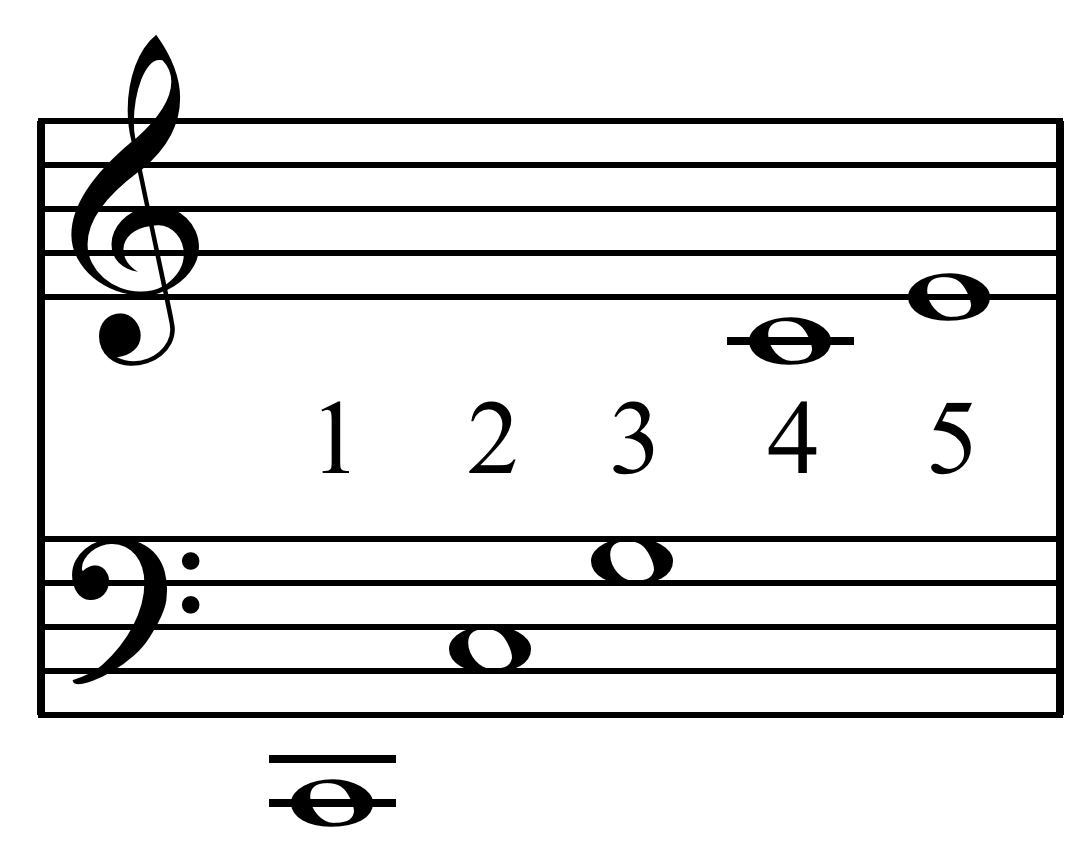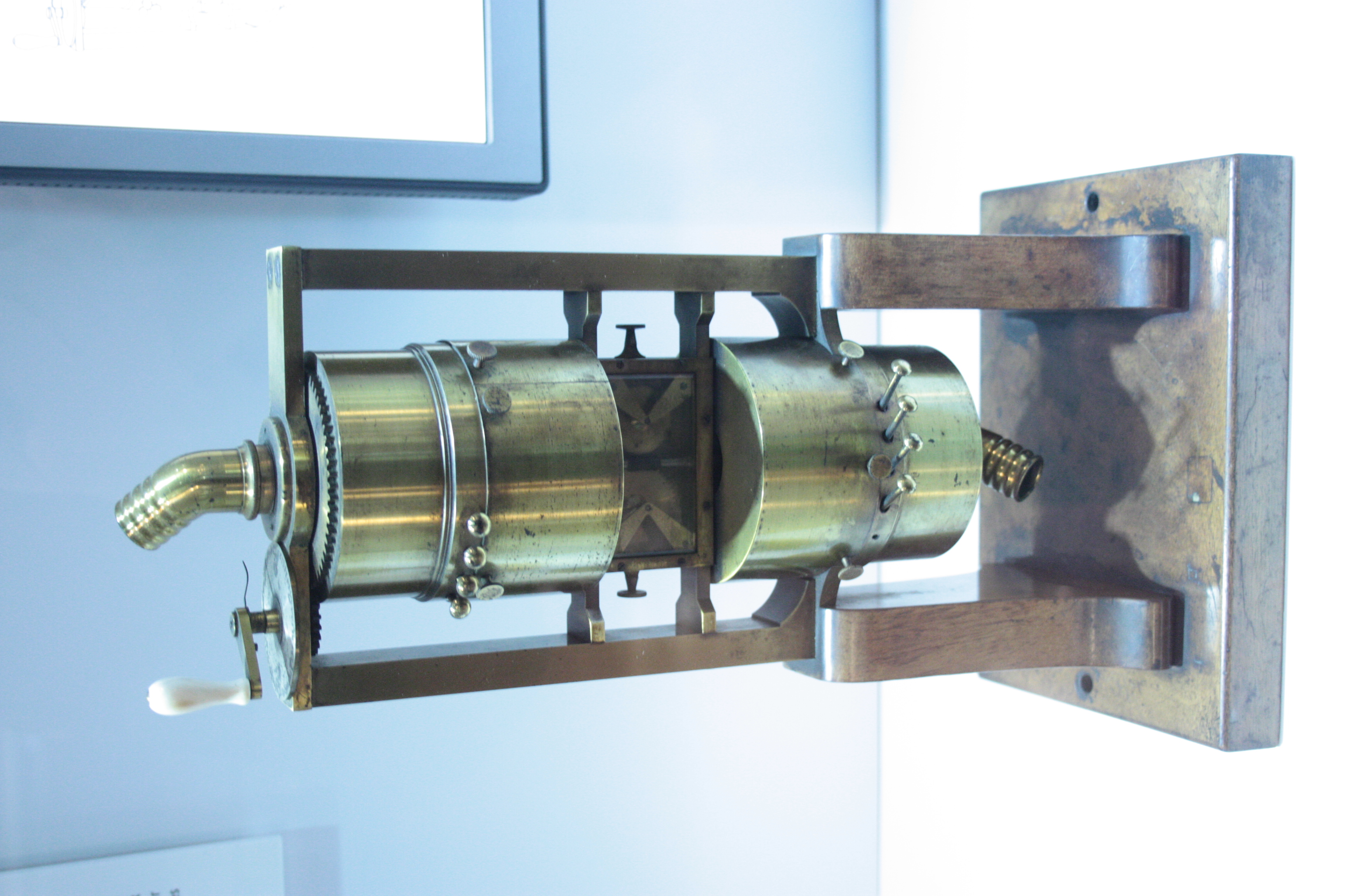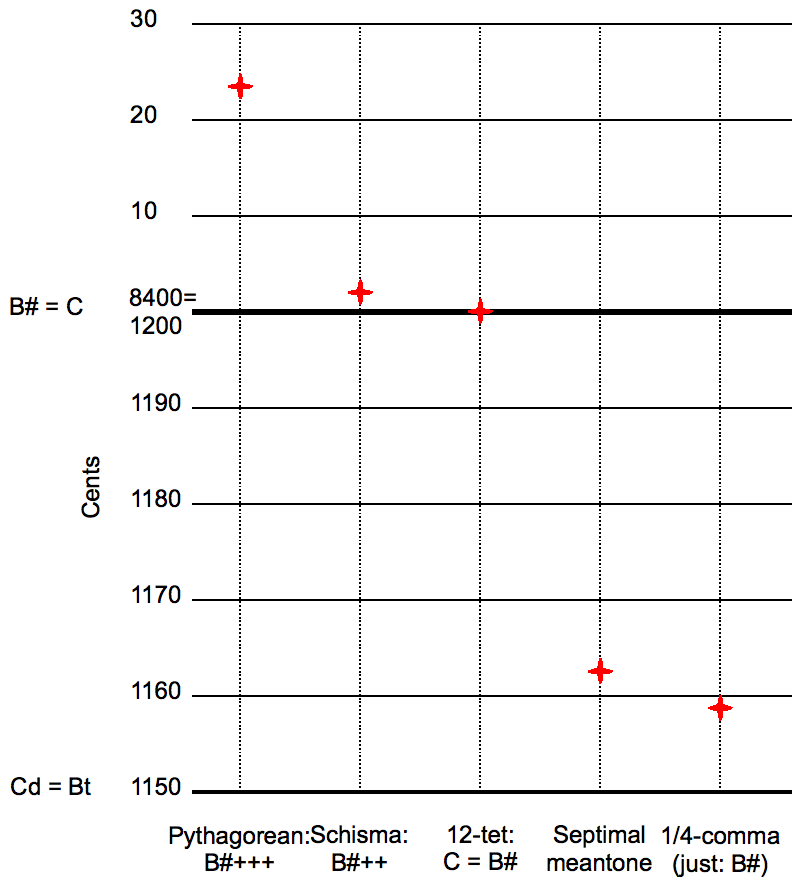|
Schismatic Temperament
A schismatic temperament is a musical tuning system that results from tempering the schisma of 32805:32768 (1.9537 cents) to a unison. It is also called the schismic temperament, Helmholtz temperament, or quasi-Pythagorean temperament. Construction In Pythagorean tuning all notes are tuned as a number of perfect fifths (701.96 cents ). The major third above C, E, is considered four fifths above C. This causes the Pythagorean major third, E (407.82 cents ), to differ from the just major third, E (386.31 cents ): the Pythagorean third is sharper than the just third by 21.51 cents (a syntonic comma ). C — G — D — A — E Ellis's "skhismic temperament". instead uses the note eight fifths ''below'' C, F (384.36 cents ), the Pythagorean diminished fourth or schismatic major third. Though spelled "incorrectly" for a major third, this note is only 1.95 cents (a schisma) flat of E, and thus more in tune than the Pythagorean major third. As Ellis puts it, "the Fifths should be ... [...More Info...] [...Related Items...] OR: [Wikipedia] [Google] [Baidu] |
Musical Tuning
In music, there are two common meanings for tuning: * Tuning practice, the act of tuning an instrument or voice. * Tuning systems, the various systems of pitches used to tune an instrument, and their theoretical bases. Tuning practice Tuning is the process of adjusting the pitch of one or many tones from musical instruments to establish typical intervals between these tones. Tuning is usually based on a fixed reference, such as A = 440 Hz. The term "''out of tune''" refers to a pitch/tone that is either too high (sharp) or too low (flat) in relation to a given reference pitch. While an instrument might be in tune relative to its own range of notes, it may not be considered 'in tune' if it does not match the chosen reference pitch. Some instruments become 'out of tune' with temperature, humidity, damage, or simply time, and must be readjusted or repaired. Different methods of sound production require different methods of adjustment: * Tuning to a pitch with one's voic ... [...More Info...] [...Related Items...] OR: [Wikipedia] [Google] [Baidu] |
Equal Temperament
An equal temperament is a musical temperament or tuning system, which approximates just intervals by dividing an octave (or other interval) into equal steps. This means the ratio of the frequencies of any adjacent pair of notes is the same, which gives an equal perceived step size as pitch is perceived roughly as the logarithm of frequency. In classical music and Western music in general, the most common tuning system since the 18th century has been twelve-tone equal temperament (also known as 12 equal temperament, 12-TET or 12-ET; informally abbreviated to twelve equal), which divides the octave into 12 parts, all of which are equal on a logarithmic scale, with a ratio equal to the 12th root of 2 ( ≈ 1.05946). That resulting smallest interval, the width of an octave, is called a semitone or half step. In Western countries the term ''equal temperament'', without qualification, generally means 12-TET. In modern times, 12-TET is usually tuned relative to a standard pitch of ... [...More Info...] [...Related Items...] OR: [Wikipedia] [Google] [Baidu] |
Mark Lindley
Mark Lindley (born 1937) is a noted musicologist and, more recently, a historian of modern India, and a teacher of economics. Born in Washington, D.C., he studied at Harvard University (A.B.), the Juilliard School of Music (M.S.) and Columbia University (D. Phil.). He has taught at various universities, including Columbia University, City University of New York, Washington University, University of London, Oxford University, University of Regensburg, Chinese University of Hong Kong, University of Kerala, Istanbul Technical University, Yildiz Technical University, Bogaziçi University, and the University of Hyderabad, where he served in 2015 as the University Chair professor in the School of Economics. He has also lectured on economics at Gujarat Vidyapith, at Dr. Babasaheb Ambedkar Marathwada University and at the Gokhale Institute of Politics and Economics. He has held research fellowships at the Gandhi Research Foundation, and was a visiting professor in 2016 at the University of ... [...More Info...] [...Related Items...] OR: [Wikipedia] [Google] [Baidu] |
Eduardo Sabat-Garibaldi
Eduardo is the Spanish and Portuguese form of the male given name Edward. Another version is Duarte. It may refer to: Association football * Eduardo Bonvallet, Chilean football player and sports commentator * Eduardo Carvalho, Portuguese footballer * Eduardo "Edu" Coimbra, Brazilian footballer * Eduardo Costa, Brazilian footballer * Eduardo da Conceição Maciel, Brazilian footballer * Eduardo da Silva, Brazilian-born Croatian footballer * Eduardo Adelino da Silva, Brazilian footballer * Eduardo Ribeiro dos Santos, Brazilian footballer * Eduardo Gómez (footballer), Chilean footballer * Eduardo Gonçalves de Oliveira, Brazilian footballer * Eduardo Jesus, Brazilian footballer * Eduardo Martini, Brazilian footballer * Eduardo Ferreira Abdo Pacheco, Brazilian footballer Music * Eduardo (rapper), Carlos Eduardo Taddeo, Brazilian rapper * Eduardo De Crescenzo, Italian singer, songwriter and multi-instrumentalist Politicians * Eduardo Año, Filipino politician and retir ... [...More Info...] [...Related Items...] OR: [Wikipedia] [Google] [Baidu] |
Just Intonation
In music, just intonation or pure intonation is the tuning of musical intervals Interval may refer to: Mathematics and physics * Interval (mathematics), a range of numbers ** Partially ordered set#Intervals, its generalization from numbers to arbitrary partially ordered sets * A statistical level of measurement * Interval e ... as whole number ratios (such as 3:2 or 4:3) of Frequency, frequencies. An interval (music), interval tuned in this way is said to be pure, and is called a just interval. Just intervals (and chords created by combining them) consist of tones from a single harmonic series (music), harmonic series of an implied fundamental frequency, fundamental. For example, in the diagram, if the notes G3 and C4 (labelled 3 and 4) are tuned as members of the harmonic series of the lowest C, their frequencies will be 3 and 4 times the fundamental frequency. The interval ratio between C4 and G3 is therefore 4:3, a just fourth (music), fourth. In Western musical practice ... [...More Info...] [...Related Items...] OR: [Wikipedia] [Google] [Baidu] |
Pump Organ
The pump organ is a type of free-reed organ that generates sound as air flows past a vibrating piece of thin metal in a frame. The piece of metal is called a reed. Specific types of pump organ include the reed organ, harmonium, and melodeon. The idea for the free reed was imported from China through Russia after 1750, and the first Western free-reed instrument was made in 1780 in Denmark. More portable than pipe organs, free-reed organs were widely used in smaller churches and in private homes in the 19th century, but their volume and tonal range were limited. They generally had one or sometimes two manuals, with pedal-boards being rare. The finer pump organs had a wider range of tones, and the cabinets of those intended for churches and affluent homes were often excellent pieces of furniture. Several million free-reed organs and melodeons were made in the US and Canada between the 1850s and the 1920s, some of which were exported. The Cable Company, Estey Organ, and Mason & ... [...More Info...] [...Related Items...] OR: [Wikipedia] [Google] [Baidu] |
Eivind Groven
Eivind Groven (8 October 1901 – 8 February 1977) was a Norwegian composer and music-theorist. He was from traditional region of Vest-Telemark and had a background in the folk music of the area. Biography Groven was born in the village of Lårdal in Telemark, Norway. Groven's rural background was filled with traditional music. He came from a family of talented musicians and artists, prominent in his home area. His father, Olav Åsmundsson Gjøitil (1865–1947) was the youngest of eight siblings. Two of his father's brothers played the hardanger fiddle. His mother, Aslaug Rikardsdotter Berge (1863–1946), was the youngest daughter of Rikard Aslaksson Berge, known for preserving a great amount of old tunes, religious songs and dance-tunes and a friend of Myllarguten's. Two of Groven's maternal uncles also played the hardanger fiddle, and his mother's sisters, as well as Aslaug herself, were talented folk singers. Groven was the youngest of five brothers. Two of his brothers b ... [...More Info...] [...Related Items...] OR: [Wikipedia] [Google] [Baidu] |
Hermann Von Helmholtz
Hermann Ludwig Ferdinand von Helmholtz (31 August 1821 – 8 September 1894) was a German physicist and physician who made significant contributions in several scientific fields, particularly hydrodynamic stability. The Helmholtz Association, the largest German association of research institutions, is named in his honor. In the fields of physiology and psychology, Helmholtz is known for his mathematics concerning the eye, theories of vision, ideas on the visual perception of space, color vision research, the sensation of tone, perceptions of sound, and empiricism in the physiology of perception. In physics, he is known for his theories on the conservation of energy, work in electrodynamics, chemical thermodynamics, and on a mechanical foundation of thermodynamics. As a philosopher, he is known for his philosophy of science, ideas on the relation between the laws of perception and the laws of nature, the science of aesthetics, and ideas on the civilizing power of science. ... [...More Info...] [...Related Items...] OR: [Wikipedia] [Google] [Baidu] |
53 Equal Temperament
In music, 53 equal temperament, called 53 TET, 53 EDO, or 53 ET, is the tempered scale derived by dividing the octave into 53 equal steps (equal frequency ratios). Each step represents a frequency ratio of 2, or 22.6415 cents (), an interval sometimes called the Holdrian comma. 53-TET is a tuning of equal temperament in which the tempered perfect fifth is 701.89 cents wide, as shown in Figure 1. The 53-TET tuning equates to the unison, or ''tempers out'', the intervals , known as the schisma, and , known as the kleisma. These are both 5 limit intervals, involving only the primes 2, 3 and 5 in their factorization, and the fact that 53 ET tempers out both characterizes it completely as a 5 limit temperament: it is the only regular temperament tempering out both of these intervals, or commas, a fact which seems to have first been recognized by Japanese music theorist Shohé Tanaka. Because it tempers these out, 53-TET can b ... [...More Info...] [...Related Items...] OR: [Wikipedia] [Google] [Baidu] |
Syntonic Comma
In music theory, the syntonic comma, also known as the chromatic diesis, the Didymean comma, the Ptolemaic comma, or the diatonic comma is a small comma type interval between two musical notes, equal to the frequency ratio 81:80 (= 1.0125) (around 21.51 cents). Two notes that differ by this interval would sound different from each other even to untrained ears, , ''BBC''. but would be close enough that they would be more likely interpreted as out-of-tune versions of the same note than as different notes. The comma is also referred to as a Didymean comma because it is the amount by which Didymus corrected the |
Musical Temperament
In musical tuning, a temperament is a tuning system that slightly compromises the pure intervals of just intonation to meet other requirements. Most modern Western musical instruments are tuned in the equal temperament system. Tempering is the process of altering the size of an interval by making it narrower or wider than pure. "Any plan that describes the adjustments to the sizes of some or all of the twelve fifth intervals in the circle of fifths so that they accommodate pure octaves and produce certain sizes of major thirds is called a ''temperament''." Temperament is especially important for keyboard instruments, which typically allow a player to play only the pitches assigned to the various keys, and lack any way to alter pitch of a note in performance. Historically, the use of just intonation, Pythagorean tuning and meantone temperament meant that such instruments could sound "in tune" in one key, or some keys, but would then have more dissonance in other keys. In the wo ... [...More Info...] [...Related Items...] OR: [Wikipedia] [Google] [Baidu] |
Meantone Temperament
Meantone temperament is a musical temperament, that is a tuning system, obtained by narrowing the fifths so that their ratio is slightly less than 3:2 (making them ''narrower'' than a perfect fifth), in order to push the thirds closer to pure. Meantone temperaments are constructed the same way as Pythagorean tuning, as a stack of equal fifths, but it is a ''temperament'' in that the fifths are not pure. Notable meantone temperaments Equal temperament, obtained by making all semitones the same size, each equal to one-twelfth of an octave (with ratio the 12th root of 2 to one (:1), narrows the fifths by about 2 cents or 1/12 of a Pythagorean comma, and produces thirds that are only slightly better than in Pythagorean tuning. Equal temperament is roughly the same as 1/11 comma meantone tuning. Quarter-comma meantone, which tempers the fifths by 1/4 of a syntonic comma, is the best known type of meantone temperament, and the term ''meantone temperament'' is often used to refer to ... [...More Info...] [...Related Items...] OR: [Wikipedia] [Google] [Baidu] |





